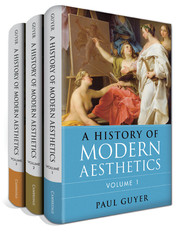Book contents
- Volume 1 The Eighteenth Century
- Frontmatter
- Epigraph
- Contents
- Acknowledgments
- Introduction
- 1 Prologue
- Part One Aesthetics in Britain, 1725–1800
- 2 From Hutcheson to Hume
- 3 Hogarth, Burke, and Gerard
- 4 From Kames to Alison and Stewart
- Part Two French Aesthetics in Mid-Century
- Part Three German Aesthetics between Wolff and Kant
- Part Four Kant and After
- Bibliography
- Index
- Volume 2 The Nineteenth Century
- Volume 3 The Twentieth Century
- References
3 - Hogarth, Burke, and Gerard
Forms of Feeling
from Part One - Aesthetics in Britain, 1725–1800
Published online by Cambridge University Press: 05 June 2015
- Volume 1 The Eighteenth Century
- Frontmatter
- Epigraph
- Contents
- Acknowledgments
- Introduction
- 1 Prologue
- Part One Aesthetics in Britain, 1725–1800
- 2 From Hutcheson to Hume
- 3 Hogarth, Burke, and Gerard
- 4 From Kames to Alison and Stewart
- Part Two French Aesthetics in Mid-Century
- Part Three German Aesthetics between Wolff and Kant
- Part Four Kant and After
- Bibliography
- Index
- Volume 2 The Nineteenth Century
- Volume 3 The Twentieth Century
- References
Summary
William Hogarth’s The Analysis of Beauty, written in 1753 and published in 1754, Edmund Burke’s A Philosophical Enquiry into the Origin of Our Ideas of the Sublime and the Beautiful, first published in 1757 and then reissued with a new “Introduction on Taste” in 1759, and Alexander Gerard’s An Essay on Taste, awarded a gold medal by the Edinburgh Society for the Encouragement of Arts, Sciences, Manufactures, and Agriculture in 1756 but first published in 1759, all develop the idea that our aesthetic responses are a free and pleasurable play of our mental powers. They nevertheless also differ from one another in key ways. First, while Hogarth follows in the tradition of Shaftesbury, Hutcheson, and Hume by treating beauty as the central category of aesthetics, Burke and Gerard return to the model of Addison and recognize a diversity of aesthetic qualities: Burke, obviously, the two mentioned in his title, and Gerard even more, including in addition to beauty and grandeur novelty, imitation, harmony, and “oddity and ridicule” as distinct objects of aesthetic response. Second, while Hogarth follows Hutcheson in emphasizing the play of our cognitive powers only in aesthetic response, Burke follows the lead of Du Bos in making the play of our emotional capacities the basis for our pleasures in both the beautiful and the sublime, and Gerard recognizes the play of both our cognitive and our moral powers as sources of pleasurable aesthetic response. None of these writers from the 1750s approach aesthetics from a traditional cognitivist point of view; rather, Hogarth emphasizes the free play of our cognitive powers in aesthetic experience to the exclusion of its emotional impact, Burke emphasizes the emotional impact of works of natural and artistic beauty and sublimity above all else, and only Gerard suggests that free play and emotional impact may be united in our experience of the diverse aesthetic categories that he recognizes. One of the jurors for the Edinburgh Society that awarded Gerard the prize for his Essay on Taste was the eminent Scottish jurist Henry Home, Lord Kames, and we will see in the next chapter that his approach to aesthetics is similar to and was perhaps influenced by Gerard’s.
- Type
- Chapter
- Information
- A History of Modern Aesthetics , pp. 140 - 175Publisher: Cambridge University PressPrint publication year: 2014



